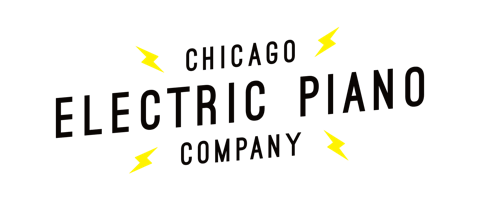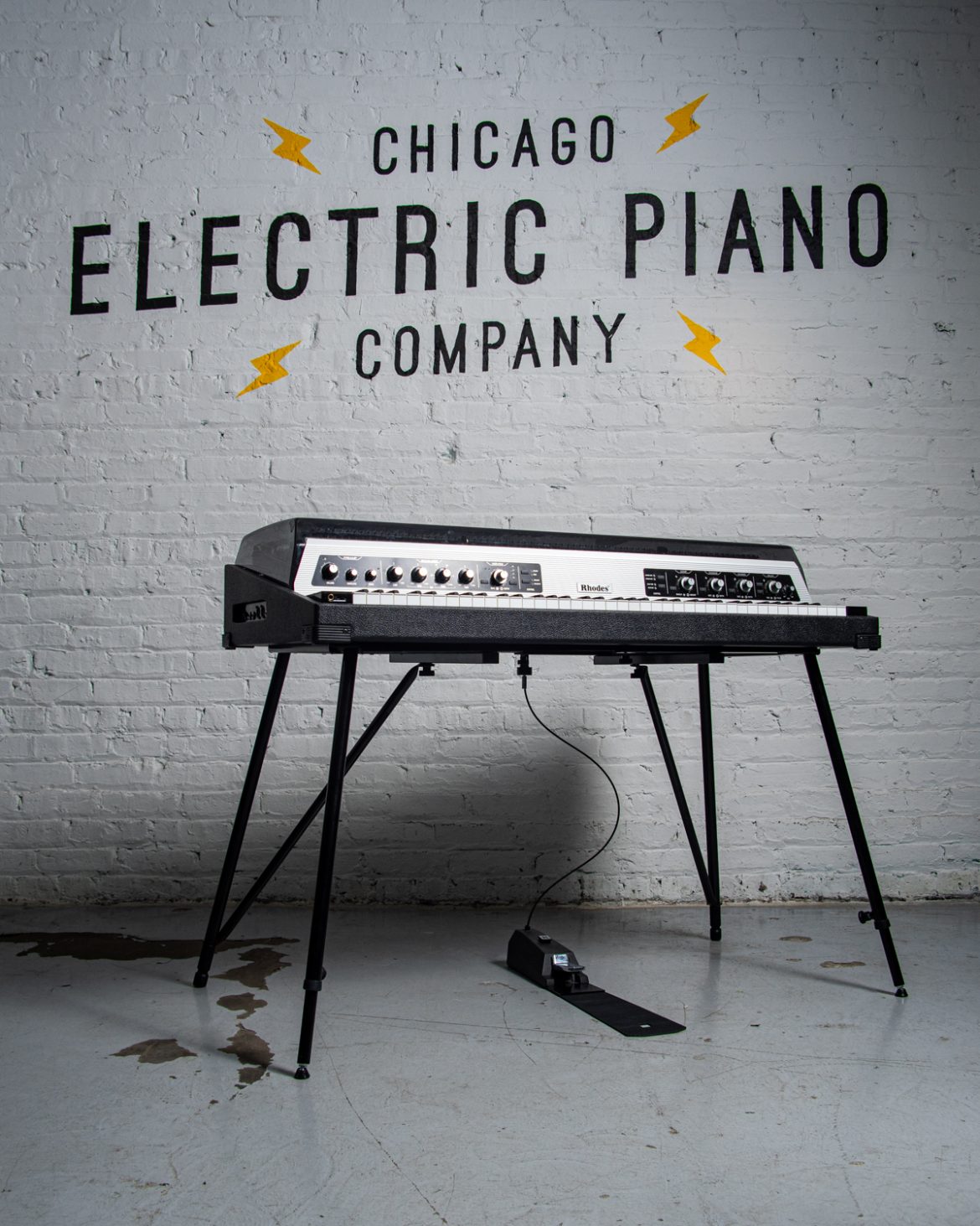
The Rhodes is back! Introducing the MK8

Rhodes is back with the all new MK8. Announced in 2021, the Rhodes brand was reborn in the United Kingdom under the direction of the new CPO Dan Goldman. After years of anticipation, we are excited to finally share our first impressions of the brand new electric piano!
Spoiler Alert! We are an authorized Rhodes dealer and service center. You can purchase the new Rhodes directly from The Chicago Electric Piano Company. Please contact info@chicagoelectricpiano.com for ordering information.


Cosmetics
At first glance, the Rhodes MK8 brings back many of the elements of the iconic 1970’s design. The rounded top with slanted edges, and the ribbed lines of the metal faceplate all pay homage to the timeless classic filtered through a modern lens.
To be honest, when images of the redesigned Rhodes first appeared online we found ourselves in an uncanny valley situation. Was this an AI job? …Many aspects felt familiar to the Rhodes Mark I look, but something was just not right. Why was the faceplate so tall? Over time, we warmed up to the new cosmetics and realized that some changes were in fact improvements on the original design.
The Rhodes MK8 is extremely customizable. There are options to choose between black tolex or an American Walnut case, black or silver faceplates, and a wide variety of lid colors. For our showroom piano we decided to implement classic elements of the Mark I and Mark II design, topped with the new “smoked” acrylic lid.
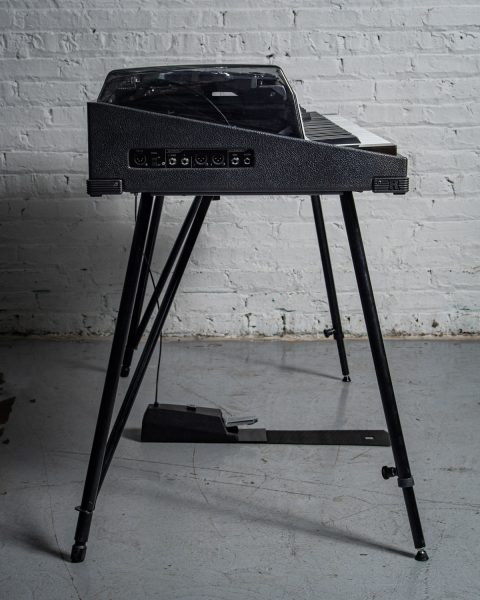

Sound
This Rhodes sounds great.
When you break it down to its core elements, this piano builds off the same fundamental tone generating principles of its forefathers. It is the real deal, and we are happy to report that it sounds just like you’d expect.
Throughout production of the Mark I in the 1970’s, component manufacturers changed on a regular basis. This resulted in small tonal and operative differences between almost every single year of production. While we can certainly go down a rabbit hole comparing all these minute variations, it is not going to be the focus of this blog post. As with vintage Rhodes from any year, hearing is believing, so for now have a listen for yourself.
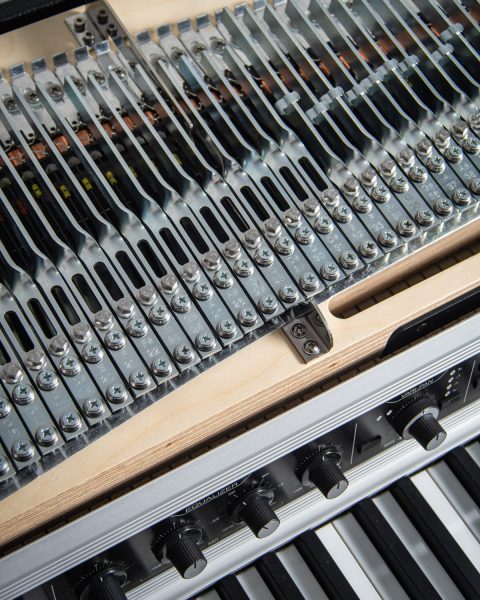
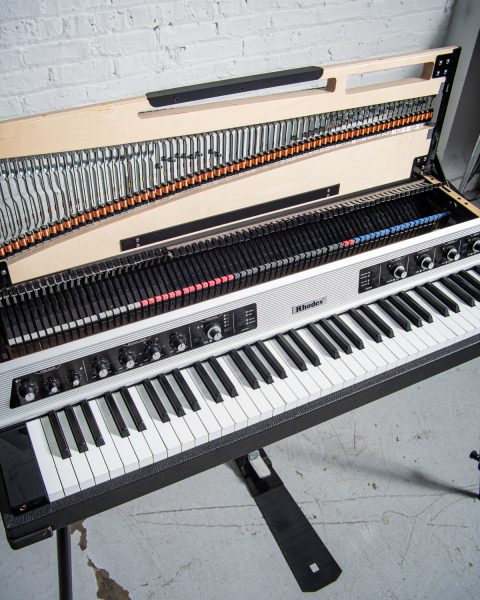
Action
Rhodes announced that they were partnered with Kluge, who manufactures the key beds for the Steinway Group, to develop the new key bed for the MK8. Along the way rumors also surrounded the new design of the action. This gave us high expectations and we have to say that those expectations were met after sitting down with the action in person.
The keys have a weight to them that we find more comparable to an acoustic piano, but with the classic feel that you expect from a Rhodes. The hammers sit level across the key bed, and the throw feels similar to the dynamic range of the Rhodes Mark V. We believe this new action design elevates the playing experience when compared to the feel of vintage Rhodes pianos. The feel is consistent, dependable, and gives the player control over each note that they play.
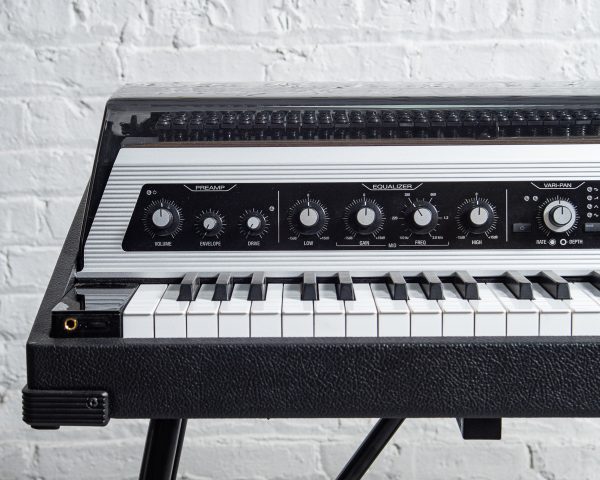
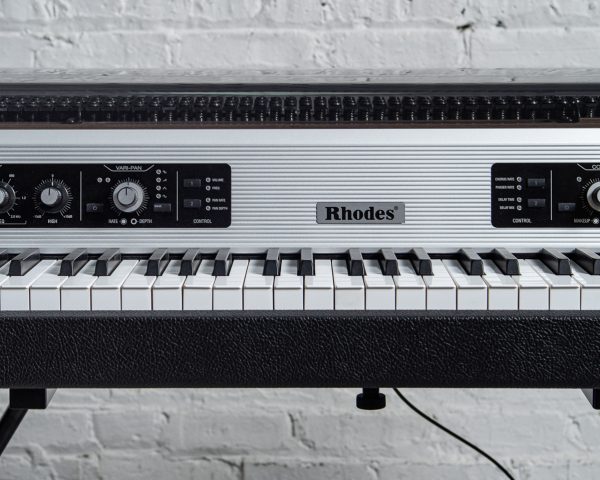

Electronics
Generally, we are fans of the “less is more” approach to creating music. Oftentimes gear with fewer variables creates a stronger connection with the user. A paradox of creativity lies at the relationship between limitations vs boundless possibilities. Given our appreciation for limitations we were initially somewhat skeptical of the new effects put into the MK8.
While two knobs might be enough for many situations (volume and tone knobs of a 1970’s Stage model going straight into a simple fender tube amp, or recording direct might be all the song needs), having a wide range of freedom to craft new tones can help stimulate or improve creative output. By far the biggest innovation in the MK8 is the immediate access to sculpt, modify, and -most of all- explore new realms of Rhodes sounds (more on those new sounds below). You can dial things back for that classic clean Rhodes sound (and you’ll be pleased with that familiar tone), but the way the instrument opens up to new sonic territories is what impressed us.
It is safe to say that this is the knobbiest Rhodes ever built. Including the upgraded effects package, and counting dual/concentric pots as two, there are a total of 18 knobs right on the face panel of the instrument. This is in addition to a number of switches that can be used to adjust secondary “alternative modes” that almost double the amount of user-adjustable parameters! And then there’s also two expression pedal ports, which enable you to set many of the knobby controls to your foot.
While this many features might sound intimidating at first, the controls are extremely intuitive and easy to use (even the “alt modes”). This Rhodes embraces the “boundless possibilities” realm of creativity that we mentioned so let’s have a closer look at all the bounty of features…
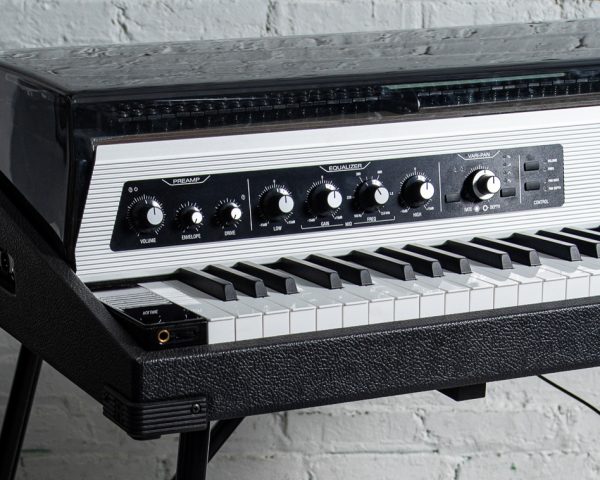
Preamplifier
The MK8’s preamplifier has been reimagined with a completely fresh take on the Rhodes sound. The new electronics were designed by Cyril Lance (former chief engineer and head designer with Moog) and James Evans (electronics engineering manager at Rhodes Music Group), who tailored the preamplifier and effects to work beautifully with the reborn Rhodes.
While we love the classic sounds of the vintage “Peterson” and “Janus” preamps, their EQ circuits are limited in range and controls are often left in a “set it and forget it” position by players. By comparison, the MK8 offers a lot more precise control with its resonant mid range envelope and gain/cut frequency controls. This new preamplifier provides the widest variety of usable EQ settings we’ve experienced on any Rhodes preamplifiers (including aftermarket products).
Stereo tremolo is a quintessential part of the Rhodes suitcase sound, and the new MK8 Vari-Pan takes this feature to new territories. First, there are multiple wave forms to choose from that alter the character of the tremolo. On top of that, once the speed control knob passes the 12 o’clock position, the effect transitions from tremolo to a ring modulation, adding a whole new realm to this effect.
The envelope and drive are the other two new features of this preamplifier. The envelope works directly with the midrange filter, and in addition to adjusting the EQ response it can also be used for touch and frequency sensitive wah sounds. Drive is a clipping circuit that can sometimes get muddy with Rhodes’ lush overtones. In our experience, a little bit goes a long way. However, integrating this with the other on board effects has resulted in a new dimension of experimental sounds.
With the envelope, drive, and ring mod circuit engaged, the Rhodes can alter itself like a chameleon to take on the tonal characteristics of a vintage combo organ or synthesizer. At first glance this may appear to be a simple masking of the Rhodes sound. However, there is a direct correlation between the player’s dynamic touch and the response of these electronics. This is the magic combination! Along with the onboard effects upgrade we believe this is what gives the MK8 a sound of its own.

Onboard Effects Upgrade
The onboard effects package is currently offered as an upgrade, but in our opinion this is a “must have” for most owners. The package includes a compressor, chorus, phaser, and delay, all of which are custom tailored by Cyril and James to pair beautifully with the full range of the MK8.
These electronics are a work of art and the Rhodes team did an absolutely beautiful job tailoring the preamp and effects for use with this Rhodes. For the sake of this post we will assume our readers have a basic understanding of how these effects operate. Here are some of the things we would like to highlight:
Compressor: This is really where the details get pushed to the surface or flattened out. The alternative mode features also allow you to adjust the compression ratio and the way it interacts with the Drive sounds.
Chorus + Phaser: Excellent sounds on both. These are both stereo effects so you’ll get the most out of them when used in stereo mixes. Alternative controls within these features allow you to modify the frequency response or chorus time.
Delay: Bucket brigade delay with tap tempo. The alternate mode within the delay effect allows you to adjust the stereo imaging spread of the delay.
The signal path for the effects upgrade puts the compression before the drive, then the EQ controls, followed by the chorus, phaser, and delay. Last, but not least, the signal goes to the VariPan on the way to the main output.

MIDI capabilities ???
The panel has a midi output on it, but that design is currently still under development. If it is as thorough as the rest of the electronics developed for this piano, we think it’ll be phenomenal. We are really excited to see how the MIDI works compared to the QRS system we have been using in vintage Rhodes restorations. (And hopefully it will be available for installation in vintage restorations).

A final innovation worth noting…
One of the most exciting updates to the Rhodes design is the implementation of a cable pull sustain system. We first became aware of this as a modification to vintage Rhodes pianos by Ken Rich, who manufactured a system that allowed Wurlitzer sustain pedals to be used in place of a Rhodes pedal. Owners of vintage Rhodes Stage models know that one of the biggest headaches is getting the sustain setup properly, and the new MK8 “pull” system allows you to position the pedal wherever is most ergonomic for you (or your pedal board).

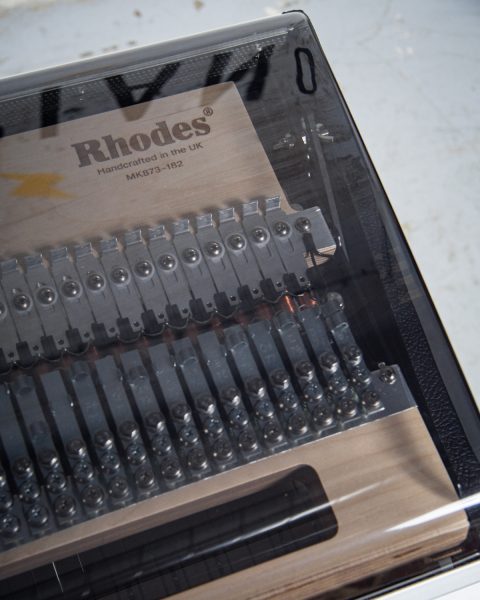
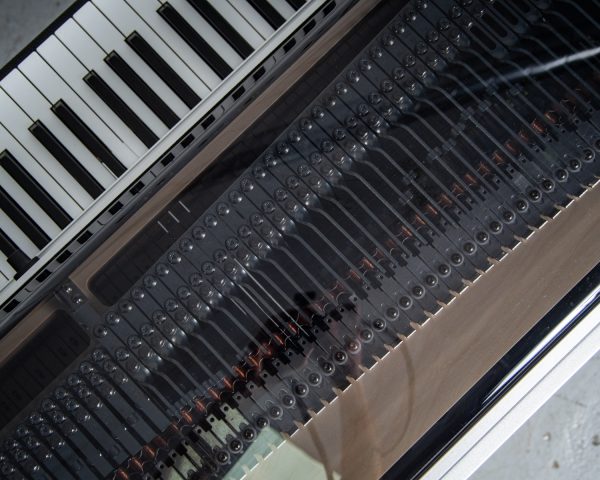

Is the MK8 the greatest Rhodes ever made?
One of the most frequently asked questions we get is “what is the best year of the Rhodes?” Our answer has always been the same: there are great pianos from every year of production.
When it comes to vintage Rhodes pianos, they are impacted by how well they have been cared for in the decades since leaving the factory. Elements such as how heavily the instrument was played, how it was transported to gigs, and especially exposure to environmental conditions such as moisture play a critical role. Vintage pianos are going to be limited by the age of their rubber and plastic components. Additionally, the majority of the Rhodes on the used market are in dire need of a professional setup, so they simply aren’t comparable to a brand new (or expert restored) piano. In the end, a Rhodes is only going to play and sound as good as the condition of its parts and the quality of its setup, and for that reason a brand new instrument is going to have a lot of advantages.
So how does the MK8 fit into the history of these pianos? We believe the quality of the design and craftsmanship is off to a great start. The sound and playability are terrific, and all who have demoed it in our showroom have left inspired. While it may be too soon to call the MK8 an instant classic, we can happily confirm this new iteration of Rhodes upholds the legacy of this iconic brand.

Come play it at The Chicago Electric Piano Company’s showroom.
You can play this Rhodes MK8 alongside a wide selection of restored vintage keyboards at our Workshop Showroom.
Our showroom is currently by appointment, so make sure to call ahead at (312)476-9528.
We are at the workshop most weekdays between 9-5. Weeknights and evenings are usually available with advanced notice.
